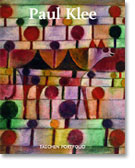The making of art as a simile for the creation of the world
As in Novalis's texts, we find a unification of oppositions in Paul Klee's work. Mysticism and logic, poetry and mathematics, day and night, metaphysical and physical realms, the visible and the invisible, the conscious and the unconscious, childlike naivety and aesthetic sophistication, death and life, the organic and the inorganic, East and West, order and anarchy, irony and commitment, are often simultaneously present.
For Klee, the making of art was a simile for the creation of the world. Like Goethe, whom he considered the "only bearable German", and whose experience of nature seemed allied to his own, Klee attempted to capture nature in terms of primal images; and like the poet, the artist discovered "analogies to the universal design in the tiniest leaf".
On an early trip to Italy, undertaken with the Swiss sculptor Hermann Haller, Klee was intrigued less by the legacy of visual artists ? with the exception of Leonardo ? than by the structural principles of Italian architecture, which he saw as a continuation of natural laws by human hands, and by the fantastic aquatic flora and fauna in the Naples aquarium. Between these two poles lay the garden, organic nature domesticated and shaped by man, which inspired many of Klee's finest pictures. And it was between these two poles, those of construction and imagination, that his rich œuvre slowly and continually developed.
The Paul Klee portfolio features high quality prints that beg to be framed. Tucked in the portfolio are 14 large-format reproductions, each with a brief description.
As in Novalis's texts, we find a unification of oppositions in Paul Klee's work. Mysticism and logic, poetry and mathematics, day and night, metaphysical and physical realms, the visible and the invisible, the conscious and the unconscious, childlike naivety and aesthetic sophistication, death and life, the organic and the inorganic, East and West, order and anarchy, irony and commitment, are often simultaneously present.
For Klee, the making of art was a simile for the creation of the world. Like Goethe, whom he considered the "only bearable German", and whose experience of nature seemed allied to his own, Klee attempted to capture nature in terms of primal images; and like the poet, the artist discovered "analogies to the universal design in the tiniest leaf".
On an early trip to Italy, undertaken with the Swiss sculptor Hermann Haller, Klee was intrigued less by the legacy of visual artists ? with the exception of Leonardo ? than by the structural principles of Italian architecture, which he saw as a continuation of natural laws by human hands, and by the fantastic aquatic flora and fauna in the Naples aquarium. Between these two poles lay the garden, organic nature domesticated and shaped by man, which inspired many of Klee's finest pictures. And it was between these two poles, those of construction and imagination, that his rich œuvre slowly and continually developed.
The Paul Klee portfolio features high quality prints that beg to be framed. Tucked in the portfolio are 14 large-format reproductions, each with a brief description.














